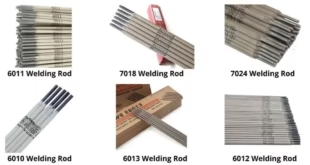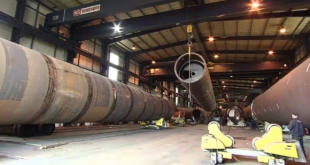Sheet and Plate Metal Welding
Introduction
Sheet and plate metal welding is a critical process in the realm of metalworking and manufacturing. It involves joining flat metal pieces together to create various structures and components, using various welding techniques. This article explores the fundamentals and significance of sheet and plate metal welding, the common types of metals involved, and the crucial role it plays in various industries.
Sheet and plate metal welding, at its core, is the process of fusing two or more metal sheets or plates together to form a strong and cohesive joint. This fusion is achieved through the application of heat, pressure, and sometimes a filler material, depending on the welding method used. The primary objective is to create a bond that is as strong as the base metal itself, ensuring the structural integrity of the final product.

Types of Sheet and Plate Metals Commonly Welded
Sheet and plate metals used in welding come in various materials, each with its unique properties and applications. Some common types include:
- Steel: Mild steel, stainless steel, and high-strength alloys are frequently welded. Mild steel is widely used in construction, while stainless steel’s corrosion resistance is essential in food processing and medical equipment. High-strength alloys are prevalent in aerospace and automotive applications.
- Aluminum: Known for its lightweight properties and corrosion resistance, aluminum is commonly found in the aerospace industry, as well as in the production of consumer goods like appliances and furniture.
- Copper and Brass: These materials are used in electrical applications due to their excellent conductivity. Welding is crucial for joining copper and brass components in electrical systems and plumbing.
- Titanium: With its high strength-to-weight ratio and corrosion resistance, titanium is vital in aerospace, medical implants, and chemical processing equipment.
- Nickel Alloys: These are used in demanding environments such as petrochemical plants and marine applications due to their corrosion resistance and high-temperature strength.
Fundamentals of Sheet and Plate Metal Welding
Understanding Different Welding Techniques
Sheet and plate metal welding employs various techniques, each suited for different applications and materials. Here are some of the primary methods:
- Gas Metal Arc Welding (GMAW/MIG): GMAW, commonly known as Metal Inert Gas (MIG) welding, employs a wire electrode that’s continuously fed through a welding gun. The electrode melts and forms the weld, while an inert gas shields the welding area from atmospheric contamination. This method is versatile and suitable for a wide range of metals, making it popular in industries such as automotive and fabrication.
- Gas Tungsten Arc Welding (GTAW/TIG): GTAW, or Tungsten Inert Gas (TIG) welding, uses a non-consumable tungsten electrode to create the weld. This technique typically requires more skill and precision. It’s excellent for welding thin materials and is commonly used in industries requiring high-quality, precise welds, like aerospace and artistry.
- Shielded Metal Arc Welding (SMAW): SMAW, also known as stick welding, involves a consumable electrode coated in flux that creates the weld. It’s a versatile and portable method suitable for various metals and thicknesses. SMAW is widely used in construction, maintenance, and repair work.
- Flux-Cored Arc Welding (FCAW): FCAW is similar to GMAW but uses a tubular wire filled with flux instead of a solid wire. This flux shields the weld and allows welding to be done in windy or dirty conditions. FCAW is commonly used in industries like shipbuilding and structural steel fabrication.
Factors Influencing the Selection of Welding Technique
Several critical factors influence the choice of welding technique when working with sheet and plate metals:
- Metal Thickness and Type: The thickness and type of metal being welded play a significant role in determining the appropriate welding method. Thin metals might benefit from TIG welding due to its precision, while thicker metals could require the higher deposition rates of GMAW or FCAW.
- Joint Design and Configuration: The type of joint to be welded, whether it’s a butt joint, lap joint, or corner joint, influences the welding technique. Some methods are better suited for certain joint configurations, and the welding process may need to be adjusted accordingly.
- Required Strength and Aesthetics: The strength and appearance of the weld are critical considerations. While some methods may provide higher strength, others might be preferred for their clean, aesthetically pleasing weld beads. For instance, TIG welding is often chosen for its precise, visually appealing welds in applications where aesthetics matter.
Preparation for Sheet and Plate Metal Welding
Surface Preparation and Cleaning
Surface preparation is a critical precursor to successful sheet and plate metal welding. Properly cleaned and prepared surfaces ensure a high-quality weld. Steps typically involved in this process include:
- Cleaning: Removal of any contaminants, such as oil, grease, rust, or paint, from the surface of the metal using solvents, degreasers, wire brushes, or abrasive materials.
- Surface Smoothing: Smoothing out any irregularities or rough edges to ensure a clean welding surface, enhancing the quality of the weld joint.
- Surface Profile: Creating a suitable surface profile that promotes adhesion by techniques like grinding or etching, particularly when welding coated or galvanized metals.
Material Handling and Safety Precautions
Material handling and safety precautions are essential to ensure the well-being of the welder and the integrity of the materials being used:
- Proper Ventilation: Adequate ventilation in the welding area to remove fumes and gases produced during the welding process.
- Personal Protective Equipment (PPE): The use of appropriate PPE such as welding helmets, gloves, flame-resistant clothing, and eye protection to safeguard against arc radiation, sparks, and potential splatter.
- Material Handling: Careful handling of materials to prevent damage or contamination, ensuring that the metals are stored in a clean and organized environment.
- Fire Safety: Implementation of fire safety measures and the presence of fire extinguishing equipment in case of emergencies.
Joint Preparation and Fit-Up
Preparing the joint and ensuring proper fit-up significantly impacts the quality of the final weld:
- Joint Cleaning: Ensuring the joint area is also clean and free from contaminants to facilitate a strong, consistent weld.
- Fit-Up: Properly aligning and fitting the metal pieces to be welded to ensure a precise joint. This can involve clamping, tack welding, or fixturing to maintain the correct alignment during welding.
- Beveling and Edge Preparation: In some cases, beveling or chamfering the edges of the metal to be joined is necessary for deeper penetration and stronger welds, particularly with thicker materials.
Selection of Filler Materials and Gases
The choice of filler materials and gases used in the welding process is crucial for achieving the desired weld properties:
- Filler Material Selection: Choosing the appropriate filler material compatible with the base metals to be welded. The filler metal should complement the properties of the base metal and meet strength and corrosion resistance requirements.
- Gas Selection: For processes like GMAW and TIG, selecting the right shielding gas—argon, helium, or a mix of gases—based on the material being welded, the desired weld characteristics, and the welding technique.
Welding Processes for Sheet and Plate Metals
Procedure for Each Welding Technique
Different welding techniques require specific procedures to achieve successful sheet and plate metal welding:
- Gas Metal Arc Welding (GMAW/MIG):
- Prepare the welding machine, selecting the appropriate wire, shielding gas, and polarity.
- Position the workpiece, ensuring proper fit-up.
- Start the arc and maintain a consistent travel speed, adjusting the angle and distance between the gun and the workpiece as needed.
- Deposit the filler metal along the joint while moving in a controlled manner.
- Properly terminate the weld and ensure post-weld cleaning and inspection.
- Gas Tungsten Arc Welding (GTAW/TIG):
- Set up the TIG welding machine, select the right tungsten electrode, and adjust gas flow.
- Create the arc and maintain precise control over the heat input and filler metal addition.
- Employ a consistent travel speed while guiding the torch along the joint.
- Use filler metal when necessary, feeding it manually.
- Conclude the weld and post-weld cleaning before inspection.
- Shielded Metal Arc Welding (SMAW):
- Choose the appropriate electrode based on the metal and joint type.
- Strike the arc and maintain the correct angle and distance between the electrode and the workpiece.
- Move the electrode along the joint, depositing the filler metal.
- Monitor the welding parameters and electrode consumption.
- Finish the weld and carry out post-weld cleaning and inspection.
- Flux-Cored Arc Welding (FCAW):
- Set up the FCAW machine, select the suitable wire and shielding gas if required.
- Strike the arc and maintain consistent travel speed, adjusting the angle and distance from the workpiece.
- Deposit the filler metal using a continuously fed wire with flux.
- Monitor and control the welding parameters and wire feeding.
- Complete the weld, perform post-weld cleaning, and conduct inspection.
Welding Parameters and Settings for Different Thicknesses
Welding parameters and settings, including current, voltage, travel speed, and shielding gas flow, vary depending on the thickness of the sheet or plate metal:
- For thinner materials, lower amperage and voltage settings are used to prevent burn-through and excessive distortion.
- Thicker materials require higher amperage and voltage for proper penetration and fusion.
- Travel speed is adjusted to maintain a consistent bead and prevent overheating or underfill.
- Gas flow rates are tailored to protect the weld pool effectively, with higher flow for thicker metals and lower flow for thinner ones.
Precise welding parameter adjustment is crucial to achieve the desired penetration and fusion without damaging the base metal. Welding operators should consult welding procedure specifications (WPS) and welding procedure qualification records (PQR) to determine the appropriate parameters.
Troubleshooting Common Issues in Sheet and Plate Metal Welding
Sheet and plate metal welding can encounter various issues, including:
- Weld Cracking: Caused by excessive heat input, improper joint preparation, or material issues. Solution: Adjust parameters and preheat, if necessary.
- Porosity: Resulting from gas contamination. Solution: Ensure proper gas flow and check gas quality.
- Incomplete Fusion: Occurs when the weld doesn’t penetrate the base metal. Solution: Adjust heat input and travel speed.
- Excessive Spatter: Caused by incorrect parameter settings. Solution: Fine-tune parameters and electrode positioning.
- Undercutting: Grooves in the base metal near the weld. Solution: Adjust travel speed and electrode angle.
- Inconsistent Bead Shape: Irregular bead formation due to inconsistent travel speed. Solution: Maintain a steady travel speed.
- Burn-Through: Excessive penetration causing holes in thin materials. Solution: Reduce amperage and voltage.
- Slag Inclusion: Occurs when slag from the electrode isn’t removed. Solution: Clean between passes and use proper electrode techniques.
Applications and Industries Utilization
Automotive Industry
- Vehicle Manufacturing: Sheet and plate metal welding is integral to automotive production, used in assembling car bodies, frames, and various structural components.
- Chassis and Frame Construction: Welding techniques are applied in creating the chassis and frame, ensuring strength, durability, and safety of vehicles.
- Exhaust Systems and Engine Components: Welding is crucial for assembling exhaust systems, engine parts, and other critical components in the automotive sector.
Aerospace and Aviation
- Aircraft Manufacturing: Welding plays a vital role in fabricating the airframe structure, engine components, and other parts crucial for aircraft assembly.
- High Precision and Quality Standards: The aerospace industry requires high precision and adherence to stringent quality standards, making advanced welding techniques, like TIG and laser welding, essential for these applications.
- Alloy and Composite Welding: Joining different materials and alloys in aircraft components demands specialized welding techniques to ensure structural integrity and lightweight designs.
Construction and Infrastructure
- Structural Steel Fabrication: Welding is fundamental in the construction of buildings, bridges, and other infrastructure, used for joining steel beams, columns, and girders.
- Pipelines and Industrial Structures: Welding techniques are applied in the construction of pipelines, oil rigs, and industrial structures, ensuring strength and stability.
- Welded Fabrication: The construction industry relies on welded fabrication for various purposes, including gates, fences, and other customized structures.
Consumer Goods and Appliances
- Appliance Manufacturing: Welding is used in the production of appliances such as refrigerators, washing machines, and stoves, ensuring structural integrity and durability.
- Furniture and Home Goods: Metal welding is involved in the fabrication of metal furniture, lighting fixtures, and other home goods, providing both functionality and aesthetics.
- Customized Designs and Prototypes: Welding techniques allow for the creation of custom designs, prototypes, and one-of-a-kind items in the consumer goods sector.
Advanced Techniques and Innovations
Automation and Robotic Welding
- Automated Systems: Automation in sheet and plate metal welding involves the use of robotic systems equipped with advanced sensors and controls to precisely execute welding tasks.
- Advantages: Robotic welding ensures consistency, accuracy, and high production rates while reducing manual labor and material waste. These systems can handle complex welds on large-scale production lines with minimal human intervention.
- Integration with Industry 4.0: Incorporating robotics into manufacturing facilities connects these systems to the broader framework of Industry 4.0, allowing for data exchange, process optimization, and increased efficiency.
Laser Welding and Its Applications
- Laser Beam Welding: Laser technology, involving the focused heat of a laser beam, provides highly precise and localized heating for welding.
- Advantages: Laser welding offers exceptional speed, precision, and minimal heat-affected zones, making it ideal for thin sheet metal applications in industries like automotive, electronics, and medical device manufacturing.
- Fiber and Disk Lasers: Advances in laser technology, such as fiber and disk lasers, have improved welding capabilities, offering enhanced energy efficiency, control, and penetration depth.
Emerging Trends and the Future Process
- Additive Manufacturing and 3D Printing: The integration of welding processes in additive manufacturing techniques allows for the creation of complex and customized structures from sheet and plate metals.
- Hybrid Welding Processes: Combining different welding techniques, like laser and arc welding, to leverage the advantages of each, resulting in improved quality and efficiency.
- Increased Use of Automation and AI: Further advancements in robotics and artificial intelligence will lead to smarter, more adaptive welding systems capable of self-adjustment and real-time monitoring for enhanced quality control.
- Environmentally Conscious Techniques: Development of eco-friendly welding techniques, reducing emissions, optimizing energy usage, and using sustainable materials.
- Materials Science Innovations: Evolution of new metal alloys and composites designed for specific applications, requiring innovative welding methods to handle these materials.
Quality Control and Inspection
Non-Destructive Testing Methods
Non-destructive testing (NDT) techniques are crucial for assessing weld quality without causing damage to the welded component. Several methods are commonly used in sheet and plate metal welding:
- Visual Inspection: The simplest and most frequently used method, involving visual scrutiny of the weld for discontinuities, cracks, or irregularities.
- Ultrasonic Testing (UT): Using high-frequency sound waves to detect internal defects by analyzing the echoes bouncing off boundaries within the material.
- Radiographic Testing (RT): Involves the use of X-rays or gamma rays to create images of the weld and detect internal defects like cracks or inclusions.
- Magnetic Particle Testing (MT): Detects surface and near-surface flaws by applying a magnetic field and iron particles to the weld area.
- Dye Penetrant Testing (PT): Applies a liquid dye that seeps into surface-breaking defects, revealing them under UV light.
Visual Inspection Techniques
Visual inspection is an essential and primary method in weld quality assessment. Techniques involved in visual inspection include:
- Macroscopic Examination: Inspecting the weld with the naked eye or using magnification to identify discontinuities, cracks, or incomplete fusion.
- Use of Inspection Tools: Utilizing tools such as magnifying glasses, mirrors, borescopes, and cameras to access and examine difficult-to-reach areas.
- Weld Profile Measurement: Assessing the shape, size, and reinforcement of the weld bead to ensure it meets design specifications.
Mechanical and Chemical Testing for Weld Quality
- Tensile Testing: Pulling a specimen from the welded joint to evaluate its tensile strength, elongation, and other mechanical properties.
- Hardness Testing: Measures the hardness of the weld to identify any changes in the material due to the welding process.
- Bend Testing: Involves bending a specimen to determine its ductility and detect discontinuities like cracks or lack of fusion.
- Chemical Analysis: Analyzing the composition of the welded material to ensure it meets specified requirements and to detect any anomalies due to welding processes.
Environmental and Safety
Fume Extraction and Ventilation
- Fume and Gas Emissions: Welding produces fumes and gases that, if inhaled, can be hazardous to human health. Proper fume extraction systems and ventilation are crucial to remove these emissions from the welding area.
- Fume Extraction Systems: Installing efficient fume extraction systems, such as local exhaust ventilation (LEV) or general ventilation, helps remove welding fumes from the work environment.
- Local Exhaust Hoods and Booths: Using local exhaust hoods directly over the welding process and welding booths equipped with effective ventilation help contain and remove fumes at the source.
Occupational Safety Measures and Protective Equipment
- Personal Protective Equipment (PPE): Welders must use appropriate PPE, including welding helmets, gloves, flame-resistant clothing, and eye protection to shield against arc radiation, sparks, and fumes.
- Respiratory Protection: In situations where fume extraction might not eliminate all hazards, welders need respiratory protection like air-purifying respirators to prevent inhalation of harmful fumes and particulates.
- Training and Education: Proper training and education on safety procedures and the use of PPE are essential to ensure that welders are aware of potential hazards and how to protect themselves.
Environmental Impact and Sustainability Measures in Welding
- Fume and Gas Reduction: Employing advanced fume extraction systems and utilizing cleaner welding technologies to reduce emissions and minimize environmental impact.
- Recycling and Waste Management: Managing and recycling scrap metal and waste generated from welding processes to minimize environmental pollution.
- Sustainable Materials and Processes: Exploring sustainable materials and techniques in welding to reduce the environmental footprint of manufacturing processes.
- Energy Efficiency: Focusing on energy-efficient welding technologies and optimizing power usage to reduce energy consumption and promote sustainability.
FAQs
Is sheet and plate metal welding suitable for all metal types?
Sheet and plate metal welding techniques can be adapted to various metal types, but the specific approach may vary based on the material’s properties.
What are the primary factors influencing the success of welding thin metals?
Factors such as joint design, material selection, and precise control of heat input play vital roles in successful welding of thin metals.
How does welding thin metal differ from welding thicker materials?
Welding thin metals requires greater precision and control over heat input to prevent distortion and maintain structural integrity, compared to thicker materials.
Are there safety considerations unique to sheet and plate metal welding?
Safety precautions involving handling thin metals and controlling heat exposure are essential in sheet and plate metal welding to avoid hazards.
How does technological advancement impact sheet and plate metal welding?
Technological advancements lead to more efficient, precise, and automated welding processes, enhancing productivity and quality in the industry.
Conclusion
Skilled welding remains an indispensable and sought-after craft in the manufacturing world. As technological advancements surge forward, the need for skilled welders equipped to handle these sophisticated systems becomes increasingly vital. The ability to understand and implement various welding techniques, coupled with an awareness of safety and environmental concerns, is invaluable. Skilled welders play a pivotal role in ensuring the quality, safety, and innovation across diverse industries, laying the foundation for robust, safe, and sustainable products and infrastructures.
 Welding of Welders All about Welding and Welders
Welding of Welders All about Welding and Welders



